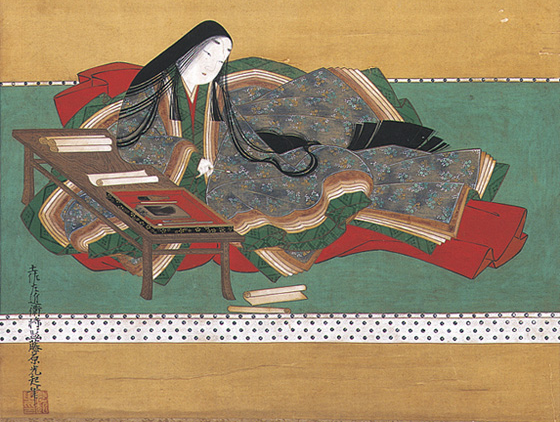
Hand-written by a master calligrapher, the manuscript is approximately 800 years old.
The Tale of Genji is often referred to as the world’s oldest novel. Predating the modern publishing industry, it’s impossible to say exactly when it was completed, but scholars say the tale of courtly drama and intrigue was in circulation by the year 1021, and its author, Murasaki Shikibu (pictured above), is thought to have passed away by 1031 at the latest.
But while The Tale of Genji is one of the most important and studied pieces of literature ever created, Murasaki’s original manuscript no longer exists, having been lost or, more likely, destroyed through the ravages of time. Because of that, modern publishings of the book take their text from hand-made copies, and researchers have just found the oldest version ever discovered.
▼ The newly discovered, very old manuscript of The Tale of Genji
源氏物語の最古の写本見つかる 藤原定家が書き写し #nhk_news https://t.co/6mk6Nc5fHJ
— NHKニュース (@nhk_news) October 8, 2019
While the newly discovered manuscript wasn’t written by Murasaki’s own hand, it does still have an impressive pedigree, as it was written by another titan of Japanese literature, Fujiwara no Sadie, also known as Fujiwara no Teika. Fujiwara, who lived from 1162 to 1241, was an important poet and author of the Kamakura period, and also an accomplished calligrapher, which explains the striking and graceful brushstroke characters in the manuscript.
▼ Researchers say that the indigo ink used in the manuscript was, during Fujiwara’s era, exclusively used by members of upper-class Japanese society.
【すごい】『源氏物語』最古の写本を発見 藤原定家が編さんした「若紫」https://t.co/3dq8IUrhvF
— ライブドアニュース (@livedoornews) October 8, 2019
所有者は愛知・三河吉田藩主だった大河内家の子孫。末尾に定家の独特の注釈が書かれている点などから判断された。
Based on the years of Fujiwara’s life, the manuscript is approximately 800 years old. 132 pages in length, it corresponds to “Wakamurasaki,” the fifth of The Tale of Genji’s 54 chapters. The Fujiwara-transcribed “Wakamurasaki” is thought to be roughly 250-300 years older than the previous oldest surviving manuscript of the chapter, and also older than the four other Fujiwara-transcribe Genji manuscripts which had already been found.
▼ The Fujiwara “Wakamurasaki” was in the possession of 72-year-old Tokyo resident Motofuyu Okouchi, a descendent of the Okouchi samurai clan that used to rule Mikawa Yoshida fief (the area around present-day Toyohashi City in Aichi Prefecture).
おおおおおまじか!
— たられば (@tarareba722) October 8, 2019
源氏物語で最古の写本発見 定家本の1帖「教科書が書き換わる可能性」 | 京都新聞 https://t.co/mqJe0YAkOb
As the oldest surviving manuscript, researchers believe Fujiwara’s may also be the most faithful to Murasaki’s original text, and could lead to new analyses and evaluations of the tale, and by extension revisions to Japanese textbooks, as it remains a staple of classical literature courses.
While the discovery itself is good news for classical culture enthusiasts, Kyoto University of Advanced Science professor and Genji scholar Junko Yamamoto also pointed out an especially heartwarming coincidence. In the “Wakamurasaki” chapter, the father of a character named Murasaki, who has been missing, is informed of his daughter’s whereabouts, just like Fujiwara’s “Wakamurasaki” has also once again been found.
Sources: NHK News Web via Jin, Yomiuri Shimbun, Kyodo
Top image: Wikipedia/Curly Turkey
● Want to hear about SoraNews24’s latest articles as soon as they’re published? Follow us on Facebook and Twitter!

 Black Thunder hotel rooms open for the summer in Aichi Prefecture
Black Thunder hotel rooms open for the summer in Aichi Prefecture The long road of the Chusonji Lotus spans nearly a millennium of Japanese history
The long road of the Chusonji Lotus spans nearly a millennium of Japanese history Embrace the literary and the historical with traditional Japanese artwork as your Zoom background
Embrace the literary and the historical with traditional Japanese artwork as your Zoom background Ancient Japanese literary works are now yours to download at the click of a button
Ancient Japanese literary works are now yours to download at the click of a button Discover your stealth skills at THE NINJA exhibit coming to Tokyo in July!
Discover your stealth skills at THE NINJA exhibit coming to Tokyo in July! McDonald’s new Happy Meals offer up cute and practical Sanrio lifestyle goods
McDonald’s new Happy Meals offer up cute and practical Sanrio lifestyle goods Japanese ramen restaurants under pressure from new yen banknotes
Japanese ramen restaurants under pressure from new yen banknotes Tokyo Tsukiji fish market site to be redeveloped with 50,000-seat stadium, hotel, shopping center
Tokyo Tsukiji fish market site to be redeveloped with 50,000-seat stadium, hotel, shopping center Studio Ghibli releases new action figures featuring Nausicaä of the Valley of the Wind characters
Studio Ghibli releases new action figures featuring Nausicaä of the Valley of the Wind characters A trip to hell on Japan’s ‘vomit ship’: Is it as bad as everyone says it is?
A trip to hell on Japan’s ‘vomit ship’: Is it as bad as everyone says it is? Sakura tree falls on man at Sannenzaka near Kiyomizu temple in Kyoto 【Breaking News】
Sakura tree falls on man at Sannenzaka near Kiyomizu temple in Kyoto 【Breaking News】 New private rooms on Tokaido Shinkansen change the way we travel from Tokyo to Kyoto
New private rooms on Tokaido Shinkansen change the way we travel from Tokyo to Kyoto Secret Kitchen bento serves Japanese flowers, birds, wind and moon in a box, but is it worth it?
Secret Kitchen bento serves Japanese flowers, birds, wind and moon in a box, but is it worth it? Beautiful Red and Blue Star luxury trains set to be Japan’s new Hokkaido travel stars
Beautiful Red and Blue Star luxury trains set to be Japan’s new Hokkaido travel stars We tried Korea’s way-too-big King Tonkatsu Burger at Lotteria 【Taste Test】
We tried Korea’s way-too-big King Tonkatsu Burger at Lotteria 【Taste Test】 All-you-can-drink Starbucks and amazing views part of Tokyo’s new 170 meter-high sky lounge
All-you-can-drink Starbucks and amazing views part of Tokyo’s new 170 meter-high sky lounge More foreign tourists than ever before in history visited Japan last month
More foreign tourists than ever before in history visited Japan last month Starbucks reopens at Shibuya Scramble Crossing with new look and design concept
Starbucks reopens at Shibuya Scramble Crossing with new look and design concept French Fries Bread in Tokyo’s Shibuya becomes a hit on social media
French Fries Bread in Tokyo’s Shibuya becomes a hit on social media Studio Ghibli glasses cases let anime characters keep an eye on your spectacles
Studio Ghibli glasses cases let anime characters keep an eye on your spectacles Is the new Shinkansen Train Desk ticket worth it?
Is the new Shinkansen Train Desk ticket worth it? Beautiful Ghibli sealing wax kits let you create accessories and elegant letter decorations【Pics】
Beautiful Ghibli sealing wax kits let you create accessories and elegant letter decorations【Pics】 Studio Ghibli releases Kiki’s Delivery Service chocolate cake pouches in Japan
Studio Ghibli releases Kiki’s Delivery Service chocolate cake pouches in Japan New definition of “Japanese whiskey” goes into effect to prevent fakes from fooling overseas buyers
New definition of “Japanese whiskey” goes into effect to prevent fakes from fooling overseas buyers Our Japanese reporter visits Costco in the U.S., finds super American and very Japanese things
Our Japanese reporter visits Costco in the U.S., finds super American and very Japanese things Studio Ghibli unveils Mother’s Day gift set that captures the love in My Neighbour Totoro
Studio Ghibli unveils Mother’s Day gift set that captures the love in My Neighbour Totoro Domino’s Japan now sells…pizza ears?
Domino’s Japan now sells…pizza ears? New Japanese KitKat flavour stars Sanrio characters, including Hello Kitty
New Japanese KitKat flavour stars Sanrio characters, including Hello Kitty New Pokémon cakes let you eat your way through Pikachu and all the Eevee evolutions
New Pokémon cakes let you eat your way through Pikachu and all the Eevee evolutions Sales of Japan’s most convenient train ticket/shopping payment cards suspended indefinitely
Sales of Japan’s most convenient train ticket/shopping payment cards suspended indefinitely Sold-out Studio Ghibli desktop humidifiers are back so Totoro can help you through the dry season
Sold-out Studio Ghibli desktop humidifiers are back so Totoro can help you through the dry season Japanese government to make first change to romanization spelling rules since the 1950s
Japanese government to make first change to romanization spelling rules since the 1950s Ghibli founders Toshio Suzuki and Hayao Miyazaki contribute to Japanese whisky Totoro label design
Ghibli founders Toshio Suzuki and Hayao Miyazaki contribute to Japanese whisky Totoro label design Doraemon found buried at sea as scene from 1993 anime becomes real life【Photos】
Doraemon found buried at sea as scene from 1993 anime becomes real life【Photos】 Tokyo’s most famous Starbucks is closed
Tokyo’s most famous Starbucks is closed One Piece characters’ nationalities revealed, but fans have mixed opinions
One Piece characters’ nationalities revealed, but fans have mixed opinions We asked a Uniqlo employee what four things we should buy and their suggestions didn’t disappoint
We asked a Uniqlo employee what four things we should buy and their suggestions didn’t disappoint Princesses, fruits, and blacksmiths: Study reveals the 30 most unusual family names in Japan
Princesses, fruits, and blacksmiths: Study reveals the 30 most unusual family names in Japan This Tokyo cafe won’t let you inside unless you’re a writer or translator with a deadline looming
This Tokyo cafe won’t let you inside unless you’re a writer or translator with a deadline looming Ridiculously awesome cherry blossom bar with sakura pool opening in Tokyo【Photos】
Ridiculously awesome cherry blossom bar with sakura pool opening in Tokyo【Photos】 Elaborately crafted doll sells for $54,000 at hard-core doll otaku event in Tokyo【Photos】
Elaborately crafted doll sells for $54,000 at hard-core doll otaku event in Tokyo【Photos】 Cosplay becomes building-play thanks to crazy inventive Initial D fan in Japan【Video】
Cosplay becomes building-play thanks to crazy inventive Initial D fan in Japan【Video】 Akashi Brewery is now offering “Moe Beer” for your thirst-quenching, otaku needs
Akashi Brewery is now offering “Moe Beer” for your thirst-quenching, otaku needs Japanese genius invents a machine just to help you get out of unwanted video chats【Video】
Japanese genius invents a machine just to help you get out of unwanted video chats【Video】 Japanese teacher has student make written apology for farting in class, displays it in classroom
Japanese teacher has student make written apology for farting in class, displays it in classroom Singing, ticking timebombs – 5 facts about the special significance of cicadas in Japan
Singing, ticking timebombs – 5 facts about the special significance of cicadas in Japan 107-year-old Japanese sisters are oldest twins in the world, according to Guinness World Records
107-year-old Japanese sisters are oldest twins in the world, according to Guinness World Records French literature classic ‘The Little Prince’ coming soon to cinemas as an animated film!
French literature classic ‘The Little Prince’ coming soon to cinemas as an animated film! Researchers closing in on “Submersible Computers” that can be cooled in the ocean
Researchers closing in on “Submersible Computers” that can be cooled in the ocean Man kidnaps, imprisons 11-year-old to raise her to be his “ideal girl”
Man kidnaps, imprisons 11-year-old to raise her to be his “ideal girl” Is this the oldest cat in the world? Japanese kitty Ai-chan turns 27 【Pics】
Is this the oldest cat in the world? Japanese kitty Ai-chan turns 27 【Pics】 Studio Ghibli offers special Spirited Away present with Toshio Suzuki exhibition tickets in Tokyo
Studio Ghibli offers special Spirited Away present with Toshio Suzuki exhibition tickets in Tokyo Dress like an aristocrat from the Nara period at new costume rental shop in Nara【Photos】
Dress like an aristocrat from the Nara period at new costume rental shop in Nara【Photos】
Leave a Reply